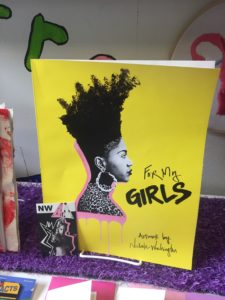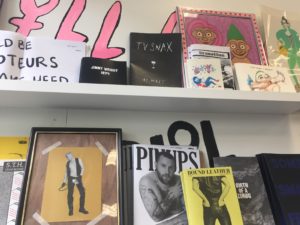Interview by Katie Cercone
Nestled inside the pastel green Mermaid Laundromat at the corner of Maria Hernandez Park is the TROLL HOLE, Bushwick’s pro-intersectional, queer, sex-positive zine shop and activist space. A “REFUGESS WELCOME” sign peeps out above the vinyl TROLL HOLE signage to bustling Knickerbocker avenue. An intimate cubicle in the corner of the Laundromat once the designated space of a cell phone retailer, the TROLL HOLE was founded in 2016 by Monica Yi, Justin Shock and Hayley Blatte. Shiny black and opalescent tinsel streamer curtains hang from off-white industrial ceiling tile amidst sex toys, free tampons and condoms, art and proudly displayed zines by womyn of color. Outside working class men of Bushwick watch their cell phones and inside, a neon sign announces the TROLL HOLE is seeking submissions of zines by women of color, trans people, gender non-conforming people, sex-workers, prison abolitionists, teens from Bushwick and non-English speakers. The TROLL HOLE mission statement concludes with “womxn of color receive a 10% discount until further notice.” Recently, Art 511 connected with TROLL HOLE co-founder Monica Yi about the politics and day-to-day of running one of underground Bushwick’s most utopic, radical spaces.
Q. What’s the story behind the name? How did you come up with it?
A. Like we’ve mentioned in other media requests, the name “Troll Hole” formed in tandem with the concept of the space. In millennial fashion, the name came out of an imessage group chat. I was asking about sex stores in Brooklyn–or a lack there of–and why the element of feminism was never in the foreground of sex positive spaces. There’s also a little reference to Hole (the band), and being a voyeuristic “troll” á la netspeak. This was back in 2014, right when the political climate got a bolt of reality. After #TrayvonMartin, the space really began to take a less frivolously sex positive shape, and became a little bit more political. The shop didn’t open until 2016.
Q. How did you all meet and what are the politics of working in a collectively owned and operated business?
A. The space was founded in 2016 by myself, Justin Shock, and Hayley Blatte. Justin is no longer involved in Troll Hole, and Hayley will be leaving the space August 1st. Hayley and I met while attending CalArts in 2006. Hayley was in fine art, my background is in graphic design. We both met Justin through a mutual friend back around 2010. The politics of working in a collective can come with its own delights and challenges. I like working collectively because there is a sounding board, and I value the opinions of people I respect. Aspiring to walk the walk and talk the talk of operating a space supporting a feminist ethos–let alone an intersectional feminism–is a constant challenge. Personally, it’s been a little difficult for me because I am the only woman of color, and macro-dynamics of those nasty -isms aren’t exclusive to organizing and collective working. “The personal is political” to borrow a 2nd wave adage. Troll Hole doesn’t exist in a vacuum, and aspects of white privilege, denial, and “ally theatrics” can play out in this space too.
Q. What are your best selling items?
A. Poppers, a zine about Audre Lorde, La Liga’s zine, The Ridgewood Youth Council’s zines, Nichole Washington’s pieces, Come on Strong’s Aileen Wuornos tees, The Softies zine, Pop Aesthete’s enamel pins… Straight white dudes exclusively buy Umberto Eco’s Ur-Fascism zine–which is the only non-LGBTQ/non-feminist zine.
Q. Let’s talk about the recent zine revival… how does it compare to the riot grrl era energy and how has social media changed the way we use and share zines?
A. Zine culture is constant, but public interest seems to ebb and flow. And you’re right that there seems to be extra attention to zines right now. The riot grrrl movement was what further propelled my interest in feminism. Unfortunately, it’s a bit of a nostalgic relic–as riot grrrl was and is still really a white feminist movement. Women of color, especially Black women, have mentioned feeling like a footnote. I’m grateful for that time, because the anger was real (and still is), except it’s 2017 now. The narrative has to move on from reclaiming the word “pussy” with knitted pink hats and centering white middle class suburban angst. How many zines can you make about the artistic uses of period blood and underarm hair?
I’m a bit conflicted about social media and feminist zine culture. There is a tangible ephemeral quality that I really enjoy about zines. You can pass these little things on, you can collect them, you can even throw them away. A lot of zine makers have resorted to Etsy or Instagram, and sometimes I think the overall branding is what gets noticed before the content. However, one really positive thing about social media and feminist zines is the access and visibility of work made by women of color. There is an explosion of narratives and content that would have easily been erased or rendered unimportant. I feel like micro blogs and Tumblr also introduced people to zines, and that is also pretty cool.
Q. What’s it like being in the laundromat?
A. Being in a laundromat is pretty cool. It’s already a communal space, so accessibility isn’t a problem. We get people from all over–it’s an accurate demographic of Bushwick. Sometimes I wish we could afford a bigger space so we could hold more events or support the community in other ways, but at the moment it’s not a big priority. And Jolina, the girl whose relatives own the laundromat, is a really big helper. 🙂
Q. Bushwick feels more gentrified than parts of Manhattan these days with rents skyrocketing to ridiculous. How is the local community keepin’ it real? What do queer, intersection feminist politics got to do with it?
A. I don’t agree that Bushwick is more gentrified than parts of Manhattan–those places in Manhattan that “aren’t gentrifying” have just plateaued. Gentrification is happening globally because affordable housing has been increasingly in crisis. The Grenfell Tower fire is a prime example of what happens when developer/corporate interest is favored over the quality of living of working class residents. What is your definition of “local community?” The Housing Planning Summit in the winter was a good indicator of who is “keepin’ it real” in Bushwick. The majority of the attendees were people of color from Bushwick. I saw very few transplants, very few newer residents, and the so-called “artists” that have made Bushwick an exploitative artist destination were practically not present. The long time residents in Bushwick are really resisting and trying to adapt, but it really does seem like an uphill battle.
Everyone’s feminism looks a little different, but by being mindfully intersectional–remembering Kimberlé Crenshaw’s concept–it serves as a reminder to not only keep challenging and critiquing the conversation about Feminism™ but also to celebrate and center the most marginalized voices.
It’s the year 2017. If anyone is going to consider themselves a feminist at this time, they must be mindful of intersectionality. Fifty-three percent of white women voted for DJT. This is willful ignorance and a willful denial of feminism. Also there is a lot of Feminist™ merchandise out there right now. To quote Flavia Dzodan, “My feminism will be intersectional. Or it will be bullshit.” Unfortunately, Dzodan’s quote also got turned into a merchandising catchphrase, where other people made money off her words. So as a retail store, we try to carry items made by people local to the area, try to emphasize marginalized voices, try to keep things as affordable as possible, and save a little room for fun.








